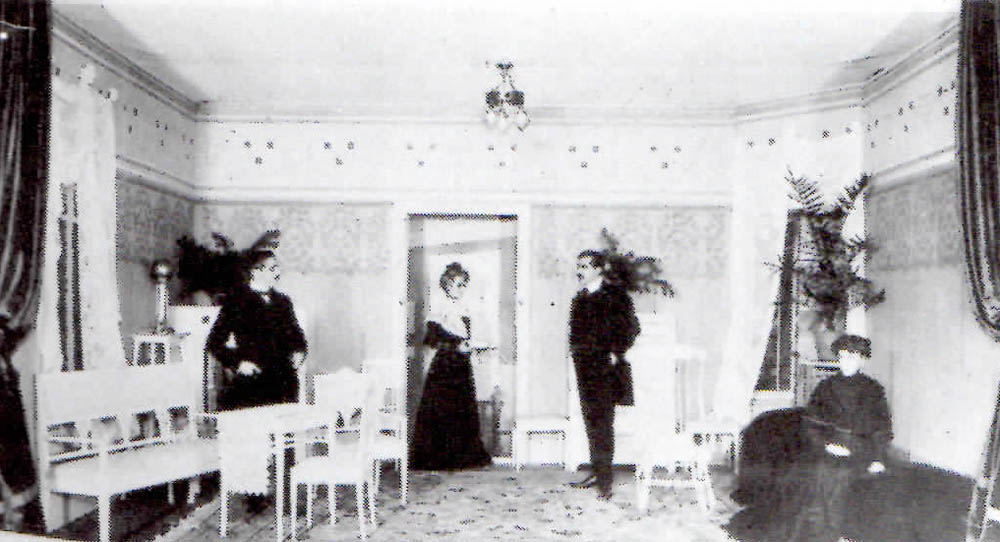By Michael Moerman, Assistant Dramatug
Though Storm is Opus One of the Chamber Plays, The Pelican was the first Chamber Play to be produced at the Intimate Theater, on 26 Nov, 1907. The first performance was sold out, but attendance dropped immediately. The show was soon replaced with a run of Strindberg’s Miss Julie.
Max Reinhardt’s expressionist production at his Berlin Kammerspiele in April of 1914 revived interest in the play, which he then toured in Vienna and Budapest. In November, 1920, he brought a revised production to Scandinavia: Copenhagen and Göteberg. The Pelican became quite popular, first in Germany. Olof Molander (1892-1966), the prominent Swedish director whose work influenced Ingmar Bergman, directed in 1922. Seven years later, The Pelican was performed at New York’s Macdougal Street Playhouse. When Ingmar Bergman first encountered the Chamber Plays (at the tender age of fourteen, he claims), it was The Pelican that especially impressed him. It was the first Chamber Play that he directed (1940), the first he directed professionally (1945) and the last Strindberg play he ever worked on (in a radio version), shortly before his death in 2007.
Of the Chamber Plays, only The Ghost Sonata is performed more often than The Pelican. Television versions were broadcast in Sweden in 1970 and again in 1982. This May (2012), Swedish radio broadcast The Pelican as part of its August Strindberg centennial celebration. In Japan, Mitsuya Miyauchi recently staged The Pelican as a Noh play. In August 1990, Jules Aaron directed a production at Second Stage (Los Angeles) for which John Iacovelli designed a distorting mirror through which the audience saw the family’s home. Other recent productions include the Orange Tree Theatre (London, March 1994), the Here Theatre (New York, January, 2000), and – of principal concern to this discussion – the Maleza Theatre Company of Santiago, Chile (July 2008).
In her perceptive analysis of this production. Miriam Felton-Dansky describes how Muriel Miranda, the director of La Pelicana, creates a child’s eye view of The Pelican’s world that parallels her audience’s limited but tantalizing understanding of the great national tragedy that defines the lives of their parents: the 1973 assassination of President Allende and consequent vicious dictatorship of General Pinochet, “a time when military police ran torture and interrogation centers… and coerced friends and colleagues into informing on each other, fostering terror and suspicion within neighborhoods and within families.”
In the Maleza Theatre Company’s La Pelicana, the “home is an enormous doll-house, and [the] embattled family is portrayed onstage by live actors and on an upstage screen by their tiny doubles, clay figurines.” The audience enters “to the tinkling strains of a music box…. The lights go down on a miniature house center stage, complete with clapboard siding and scalloped roof. Two actors split the house open, and the widening gap reveals, on one side, a blue-papered kitchen—site of the mother’s sins of gluttony—and, on the other, the father’s study, papered in pink and hiding his all-important accounting books…. Maleza turns everything onstage into a toy…. Each character is seen first as a figurine…. [A]s they approach the door, each one freezes by the window, as red block-lettering flashes above his or her head: ‘The Son-In-Law’; or ‘The Daughter…. [L]ate in the play, the father’s ghost appears [as an] animated figure telling his son where the account-books are hidden.” The production also projected video and animated film. Felton-Dansky writes that “The sweet, childlike demeanor of Maleza’s animations only underlines the characters’ clawing greed: for food, money, and each other. Maleza dissects the family’s avarice into one precisely choreographed gesture at a time. The mother convulses bulimically over a stew pot in her overly cute, overly small kitchen…. Gluttony and impotence feature in one of the production’s filmed sequences, when the daughter wheels a large television onstage and falls asleep before its flickering screen… On one channel, a nun hosts a cooking show…; on another, blood drips down the beak of a large animated pelican…. Awakening and storming the kitchen, the barren daughter confronts her vampiric mother with a bowl of … gruel, smacking her oversized wooden spoon on her undersized china stove for emphasis. By framing The Pelican in its tiny house – and, on multiple screens, framing it again – Miranda and her collaborators shrink Strindberg’s play… and, in the process, recast it as a cultural shadow-text reflecting their own murky relationship to the recent past…. The Pelican’s story is filtered through the distorted consciousness of its febrile younger generation, and the company’s choice of medium establishes its fidelity to this child’s-eye view,” the same perspective that the youthful Maleza Theatre Company and its young audience have of their nation’s great twentieth century calamity. Felton-Dansky shows us how Strindberg’s germinal text – when brought to life by creative theatre artists – can awaken to its own history an audience that is a century, a language, a culture, and half the world away from 1907 Sweden.

